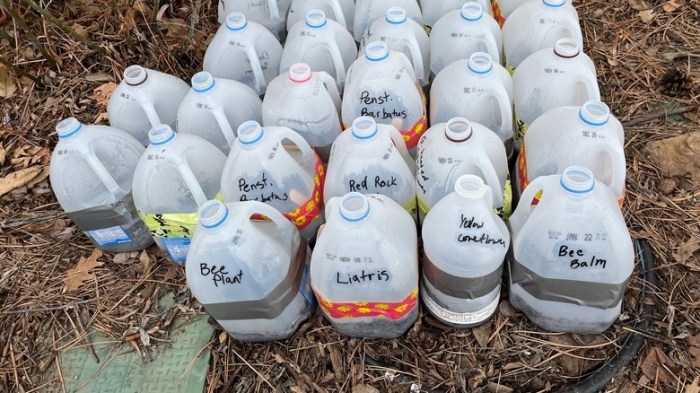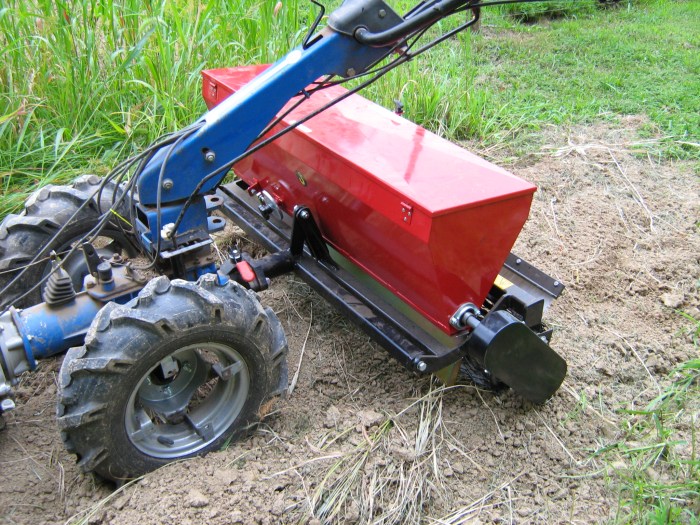DIY Grass Seed Spreader: Build Your Own for a Lush Lawn – Tired of uneven seed distribution and inconsistent lawn growth? A DIY grass seed spreader can be your solution! This guide will walk you through the process of building your own spreader, from choosing the right materials to mastering the application techniques. Whether you’re a seasoned DIY enthusiast or a beginner, this guide will equip you with the knowledge and confidence to create a spreader that meets your specific needs.
Table of Contents
Building a DIY grass seed spreader offers numerous advantages. Not only can it save you money compared to purchasing a commercial model, but it also allows for customization and a greater sense of accomplishment. By understanding the different types of spreaders and their design considerations, you can tailor your project to your specific lawn size and seed requirements.
DIY Grass Seed Spreader Designs

Building your own grass seed spreader is a cost-effective and practical way to ensure even distribution of seeds in your lawn. You can create a simple spreader using readily available materials and basic tools.
DIY Grass Seed Spreader Designs
Here are some DIY grass seed spreader designs that you can consider:
Simple Box Spreader
This design is straightforward and easy to build. You will need a rectangular box, a piece of mesh, and a handle.
- Materials:
- Wooden box (approximately 12 inches wide, 18 inches long, and 6 inches deep)
- Hardware cloth or wire mesh (to fit the bottom of the box)
- Wood screws
- Handle (a piece of wood or pipe)
- Hinges (if you want a lid)
- Tools:
- Saw
- Drill
- Screwdriver
- Measuring tape
- Instructions:
- Cut the hardware cloth or wire mesh to fit the bottom of the box.
- Attach the mesh to the box using screws.
- Attach the handle to the box using screws or hinges.
- Optionally, create a lid for the box to prevent the seeds from spilling.
Wheelbarrow Spreader
This design uses a wheelbarrow as the base, making it easier to maneuver. You will need a wheelbarrow, a piece of plywood, and some hardware.
- Materials:
- Wheelbarrow
- Plywood (to fit the bottom of the wheelbarrow)
- Hardware cloth or wire mesh (to fit the plywood)
- Screws
- Hinges
- Tools:
- Saw
- Drill
- Screwdriver
- Measuring tape
- Instructions:
- Cut the plywood to fit the bottom of the wheelbarrow.
- Attach the hardware cloth or wire mesh to the plywood using screws.
- Attach the plywood to the wheelbarrow using hinges.
- Optionally, create a lid for the plywood to prevent the seeds from spilling.
Pros and Cons of DIY Designs
- Pros:
- Cost-effective: DIY spreaders are significantly cheaper than commercially available models.
- Customization: You can design the spreader to fit your specific needs and preferences.
- Durability: Well-constructed DIY spreaders can last for many years.
- Cons:
- Time and effort: Building a DIY spreader requires time and effort.
- Limited features: DIY spreaders may lack the advanced features of commercial models.
- Potential for uneven distribution: The design of a DIY spreader can impact the evenness of seed distribution.
DIY Grass Seed Spreader Modifications
Modifying a DIY grass seed spreader can significantly enhance its functionality and make it a more versatile tool for your lawn care needs. These modifications can improve seed distribution, reduce waste, and allow for the application of other lawn care products like fertilizer.
Adding a Fertilizer Attachment
A fertilizer attachment can be a valuable addition to a DIY grass seed spreader, allowing you to apply fertilizer and seed simultaneously. This can save time and effort, as you only need to make one pass over your lawn.
Adding a fertilizer attachment to a DIY grass seed spreader can be as simple as attaching a small hopper or container to the side of the spreader. The hopper can be made from a plastic container, a metal can, or even a repurposed PVC pipe.
Here are some key considerations for adding a fertilizer attachment:
- Size and Capacity: The size of the fertilizer hopper should be appropriate for the size of your lawn. A larger hopper will allow you to cover more ground before needing to refill it.
- Material: Choose a material that is durable and resistant to corrosion. Metal or plastic are good options.
- Attachment Method: The hopper should be securely attached to the spreader using screws, bolts, or other fasteners. Ensure the attachment method is strong enough to withstand the weight of the fertilizer.
- Distribution Mechanism: The fertilizer should be distributed evenly across the lawn. This can be achieved using a simple opening at the bottom of the hopper or by incorporating a spinning disc or auger to disperse the fertilizer.
It is important to note that using a fertilizer attachment may require adjustments to the spreader’s settings to ensure even distribution of both seed and fertilizer.
DIY Grass Seed Spreader Safety

While building your own grass seed spreader can be a rewarding project, it’s crucial to prioritize safety during both construction and use. This section will Artikel important safety precautions to consider when using a DIY grass seed spreader, helping you prevent accidents and ensure a safe and successful seeding process.
Safe Handling and Operation, Diy grass seed spreader
Using a DIY grass seed spreader requires careful handling and operation to prevent accidents. Here are some essential safety tips:
- Always wear appropriate safety gear, including eye protection, gloves, and closed-toe shoes. This will protect you from flying debris, potential spills, and other hazards.
- Read and understand the instructions for your DIY spreader before using it. Familiarize yourself with its features, operating procedures, and any potential safety risks.
- Avoid operating the spreader in windy conditions. Wind can carry seed away from the target area, leading to uneven distribution and potential waste.
- Inspect the spreader regularly for any damage or wear and tear. Replace or repair any faulty parts before using the spreader.
- Use the spreader at a safe distance from people and pets. This will prevent accidental exposure to seed or injury from the spreader’s operation.
- Never leave the spreader unattended while in operation. Ensure that the spreader is turned off and properly stored when not in use.
Proper Storage and Maintenance
Proper storage and maintenance of your DIY grass seed spreader is essential for safety and longevity. Here are some key considerations:
- Store the spreader in a dry, well-ventilated area, away from direct sunlight and moisture. This will help prevent rust and corrosion.
- Clean the spreader thoroughly after each use. Remove any leftover seed, debris, or dirt. This will ensure optimal performance and prevent clogs or malfunctions.
- Lubricate any moving parts of the spreader regularly. This will reduce friction and wear and tear, extending the spreader’s lifespan.
- Inspect the spreader for any signs of damage or wear and tear before each use. Replace or repair any faulty parts promptly.
- Store the spreader safely and securely, out of reach of children and pets. This will prevent accidental injury or misuse.
DIY Grass Seed Spreader Resources

Finding the right resources can make your DIY grass seed spreader project much easier and more successful. From detailed tutorials to online communities, there are plenty of places to find inspiration, guidance, and support.
Online Resources and Tutorials
The internet is a treasure trove of information for DIY enthusiasts. You can find a wide variety of resources, including:
- YouTube Tutorials: Many YouTube channels dedicated to DIY projects feature tutorials on building grass seed spreaders. Search for s like “DIY grass seed spreader,” “homemade grass seed spreader,” or “building a grass seed spreader.”
- DIY Blogs and Websites: Websites like Instructables, Ana White, and The Family Handyman often have DIY projects related to lawn care, including grass seed spreaders. These sites usually include detailed instructions, photos, and sometimes even videos.
- Online Forums: Forums like GardenWeb, Reddit’s r/DIY, and various gardening forums are excellent places to ask questions, share ideas, and get advice from other DIY enthusiasts. You can find discussions on building grass seed spreaders, troubleshoot problems, and learn from others’ experiences.
Finding Local Resources and Workshops
Sometimes, it’s helpful to get hands-on experience and learn from local experts.
- Local Hardware Stores: Many hardware stores offer workshops and classes on various DIY projects, including lawn care. Check with your local stores to see if they offer any relevant workshops.
- Community Centers and Libraries: Community centers and libraries often host workshops and classes on various topics, including gardening and DIY. Keep an eye on their event calendars or inquire about potential workshops.
- Local Garden Clubs and Associations: Joining a local garden club or association can provide access to experienced gardeners and resources. They might offer workshops, seminars, or even have members who can provide guidance on building DIY grass seed spreaders.
Creating a DIY grass seed spreader is a rewarding endeavor that can enhance your lawn care routine and save you money in the long run. By carefully selecting materials, following the construction steps, and practicing proper application techniques, you can build a spreader that delivers even seed distribution and promotes a lush, healthy lawn. Remember, a well-maintained spreader will ensure optimal performance and a satisfying DIY experience.
A DIY grass seed spreader can be a fun and cost-effective way to revitalize your lawn, but be sure to wear a mask when working with the seed, as it can be quite dusty. Just like with the application of lupron injection , precise distribution is key for optimal results. A well-made spreader ensures even coverage, leading to a lush and healthy lawn.

